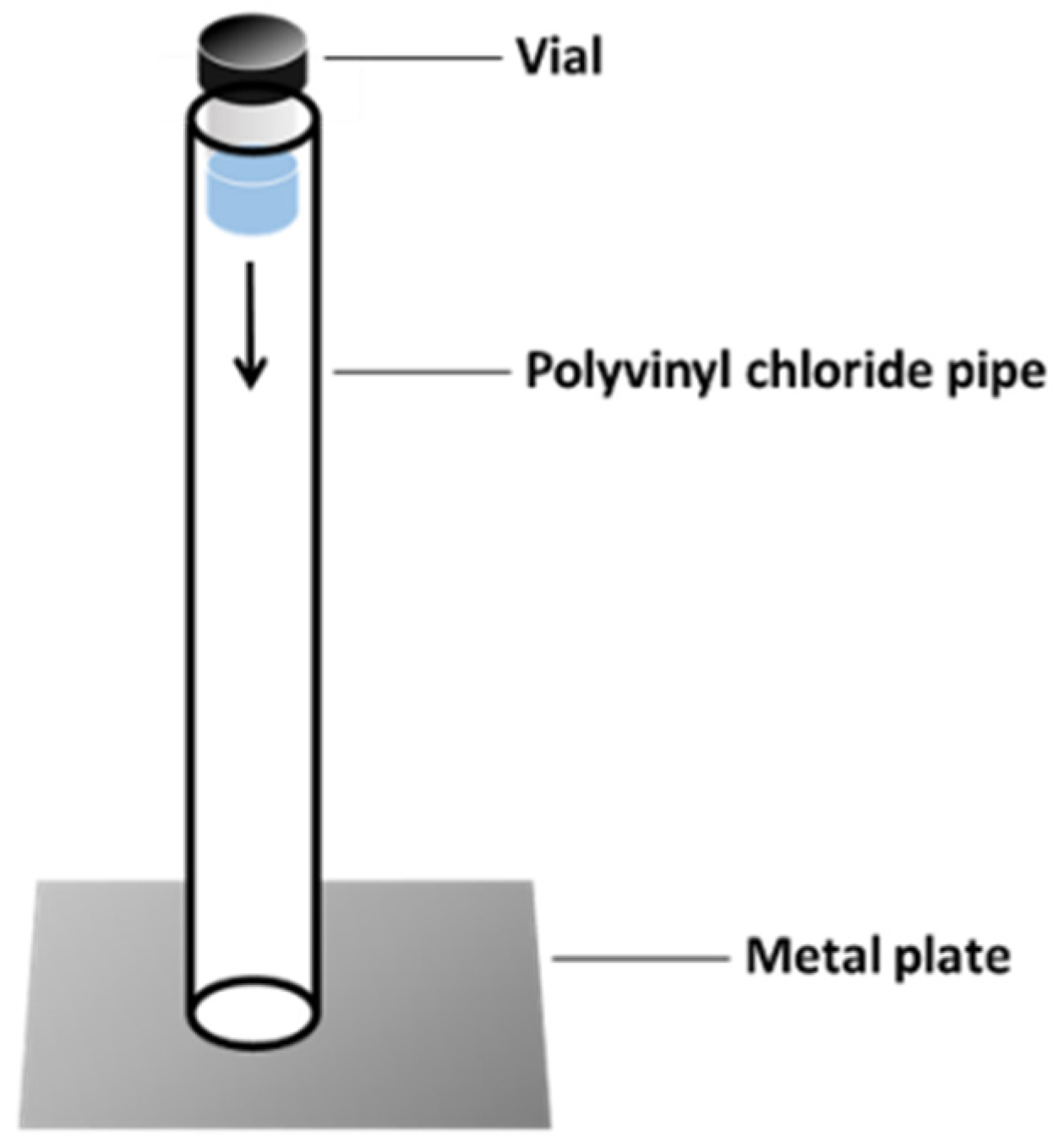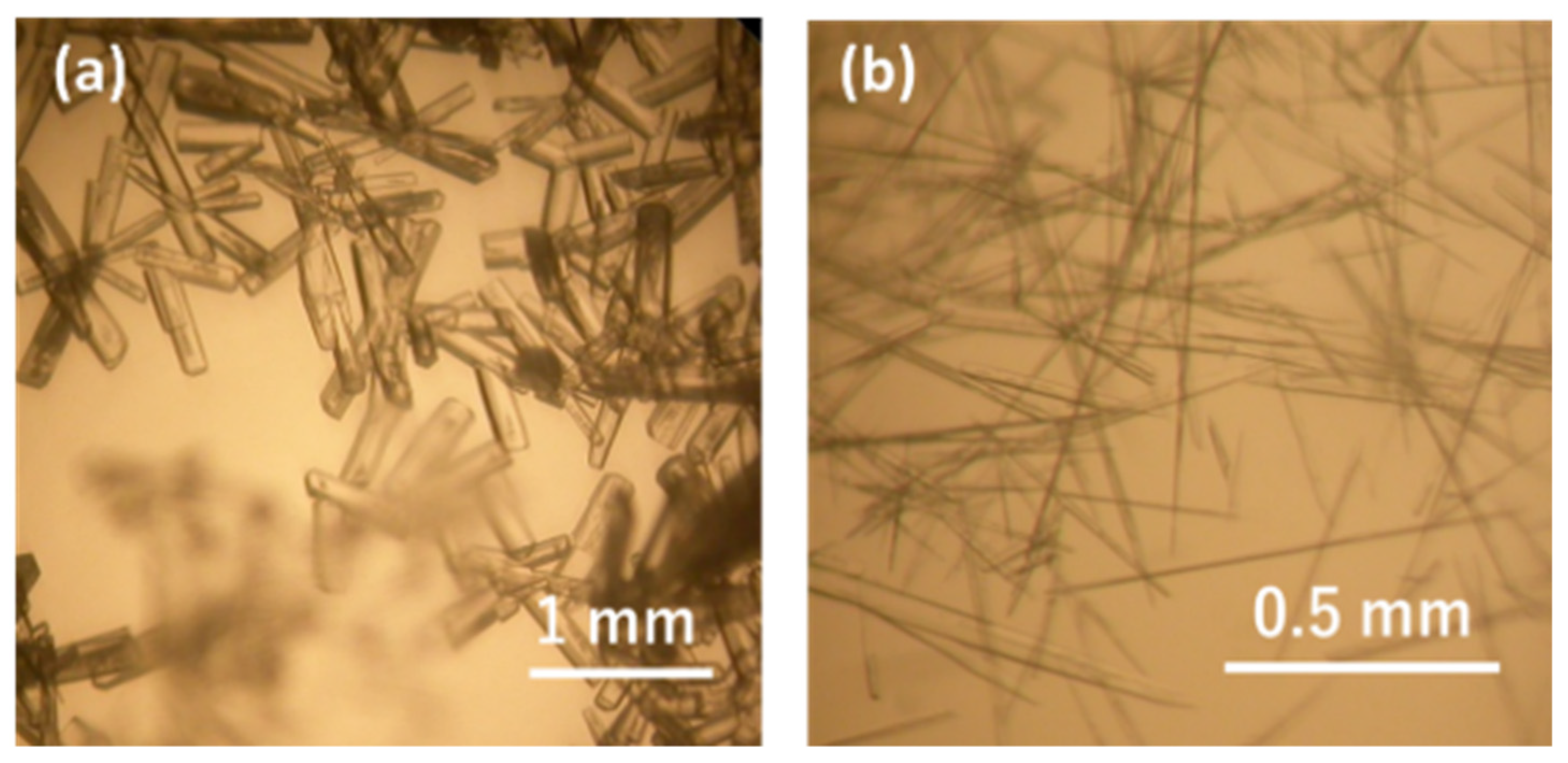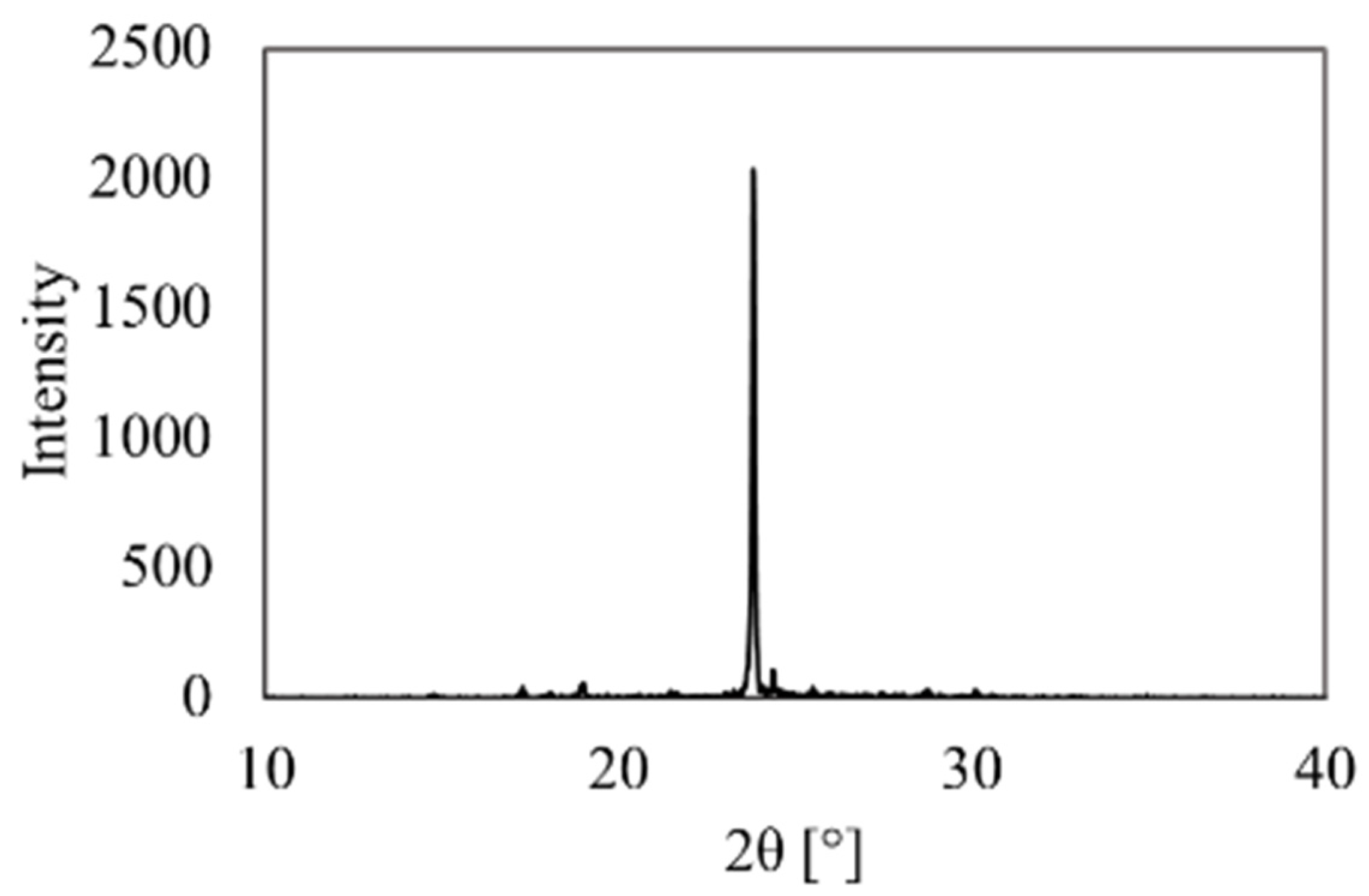Metastable Crystallization by Drop Impact
Abstract
:1. Introduction
2. Materials and Methods
3. Results and Discussion
4. Conclusions
Author Contributions
Funding
Institutional Review Board Statement
Informed Consent Statement
Data Availability Statement
Conflicts of Interest
References
- Bernstein, J. Polymorphism in Molecular Crystals; Oxford University Press: New York, NY, USA, 2002. [Google Scholar]
- Bhattachar, S.N.; Deschenes, L.A.; Wesley, J.A. Solubility: It’s not just for physical chemists. Drug Discov. Today 2006, 11, 1012–1018. [Google Scholar] [CrossRef] [PubMed]
- Gupta, H.; Kumar, S.; Roy, S.; Gaud, R. Patent protection strategies. J. Pharm. Bioallied. Sci. 2010, 2, 2–7. [Google Scholar] [CrossRef] [PubMed]
- Thayer, A.M. Centering on chirality. Chem. Eng. News 2007, 85, 11–19. [Google Scholar]
- Bučar, D.K.; Lancaster, R.W.; Bernstein, J. Disappearing polymorphs revisited. Angew. Chem. Int. Ed. 2015, 54, 6972–6993. [Google Scholar] [CrossRef] [PubMed] [Green Version]
- Nichols, G.; Frampton, C.S. Physicochemical characterization of the orthorhombic polymorph of paracetamol crystallized from solution. J. Pharm. Sci. 1998, 87, 684–693. [Google Scholar] [CrossRef] [PubMed]
- Gu, C.H.; Young, V., Jr.; Grant, D.J. Polymorph screening: Influence of solvents on the rate of solvent-mediated polymorphic transformation. J. Pharm. Sci. 2001, 90, 1878–1890. [Google Scholar] [CrossRef] [PubMed]
- Greco, K.; Bogner, R. Solution-mediated phase transformation: Significance during dissolution and implications for bioavailability. J. Pharm. Sci. 2012, 101, 2996–3018. [Google Scholar] [CrossRef]
- Maruyama, M.; Yoshimura, M.; Takano, K.; Mori, Y. Development of Polymorphic Control Technology for Pharmaceutical Compounds. In Kinetic Control in Synthetic and Self-Assembly; Numata, M., Yagai, S., Hamura, T., Eds.; Elsevier: Amsterdam, The Netherlands, 2019; pp. 269–291. [Google Scholar]
- Ikeda, K.; Maruyama, M.; Takahashi, Y.; Mori, Y.; Yoshikawa, H.; Okada, S.; Adachi, H.; Sugiyama, S.; Takano, K.; Murakami, S.; et al. Selective crystallization of the metastable phase of indomethacin on the interface of liquid/air bubble induced by the femtosecond laser irradiation. Appl. Phys. Express 2015, 8, 045501. [Google Scholar] [CrossRef]
- Mori, Y.; Maruyama, M.; Takahashi, Y.; Ikeda, K.; Fukukita, S.; Yoshikawa, H.; Okada, S.; Adachi, H.; Sugiyama, S.; Takano, K.; et al. Selective crystallization of metastable phase of acetaminophen by ultrasonic irradiation. Appl. Phys. Express 2015, 8, 065501. [Google Scholar] [CrossRef]
- Mori, Y.; Maruyama, M.; Takahashi, Y.; Yoshikawa, H.; Okada, S.; Adachi, H.; Sugiyama, S.; Takano, K.; Murakami, S.; Matsumura, H.; et al. Crystallization of acetaminophen form II by plastic-ball-assisted ultrasonic irradiation. Appl. Phys. Express 2017, 10, 025501. [Google Scholar] [CrossRef]
- Kobayashi, N.; Maruyama, M.; Mori, Y.; Fukukita, S.; Adachi, H.; Takano, K.; Murakami, S.; Matsumura, H.; Inoue, T.; Yoshimura, M.; et al. Atomic-scale imaging of surface and hydration structures of stable and metastable acetaminophen crystals by frequency modulation atomic force microscopy. J. Phys. Chem. C 2018, 122, 21983–21990. [Google Scholar] [CrossRef]
- Tsuri, Y.; Maruyama, M.; Fujimoto, R.; Okada, S.; Adachi, H.; Yoshikawa, H.; Takano, K.; Murakami, S.; Matsumura, H.; Inoue, T.; et al. Crystallization of aspirin form II by femtosecond laser irradiation. Appl. Phys. Express 2019, 12, 015507. [Google Scholar] [CrossRef]
- Yoshikawa, H.Y.; Murai, R.; Adachi, H.; Sugiyama, S.; Maruyama, M.; Takahashi, Y.; Takano, K.; Matsumura, H.; Inoue, T.; Murakami, S.; et al. Laser ablation for protein crystal nucleation and seeding. Chem. Soc. Rev. 2014, 43, 2147–2158. [Google Scholar] [CrossRef]
- Iefuji, N.; Murai, R.; Maruyama, M.; Takahashi, Y.; Sugiyama, S.; Adachi, H.; Matsumura, H.; Murakami, S.; Inoue, T.; Mori, Y.; et al. Laser-induced nucleation in protein crystallization: Local increase in protein concentration induced by femtosecond laser irradiation. J. Cryst. Growth 2011, 318, 741–744. [Google Scholar] [CrossRef]
- Randolph, W.T.; Schiltz, E.; Sederstrom, D.; Steinmann, D.; Mozziconacci, O.; Schöneich, C.; Freund, E.; Ricci, M.S.; Carpenter, J.F.; Lengsfeld, C.S. Do not drop: Mechanical shock in vials causes cavitation, protein aggregation, and particle formation. J. Pharm. Sci. 2015, 104, 602–611. [Google Scholar] [CrossRef] [PubMed] [Green Version]
- Torisu, T.; Maruno, T.; Hamaji, Y.; Ohkubo, T.; Uchiyama, S. Synergistic effect of cavitation and agitation on protein aggregation. J. Pharm. Sci. 2017, 106, 521–529. [Google Scholar] [CrossRef] [PubMed]
- Haisa, M.; Kashino, S.; Kawai, R.; Maeda, H. The monoclinic form of p-hydroxyacetanilide. Acta Crystallogr. Sect. B 1976, 32, 1283–1285. [Google Scholar] [CrossRef] [Green Version]
- Haisa, M.; Kashino, S.; Maeda, H. The orthorhombic form of p-hydroxyacetanilide. Acta Crystallogr. Sect. B 1974, 30, 2510–2512. [Google Scholar] [CrossRef]
- Burger, A. Interpretation of polymorphism studies. Acta Pharm. Technol. 1982, 28, 1–20. [Google Scholar]
- Parkin, A.; Parsons, S.; Pulham, C.R. Paracetamol monohydrate at 150 K. Acta Crystallogr. Sect. E 2002, 58, o1345–o1347. [Google Scholar] [CrossRef]
- Fabbiani, F.P.A.; Allan, D.R.; David, W.I.F.; Moggach, S.A.; Parsons, S.; Pulham, C.R. High-pressure recrystallisation—A route to new polymorphs and solvates. Cryst. Eng. Comm. 2004, 6, 505–511. [Google Scholar] [CrossRef]
- McGregor, P.A.; Allan, D.R.; Parsons, S.; Pulham, C.R. Preparation and crystal structure of a trihydrate of paracetamol. J. Pharm. Sci. 2002, 91, 1308–1311. [Google Scholar] [CrossRef] [PubMed]
- Nishigaki, A.; Maruyama, M.; Numata, M.; Kanzaki, C.; Tanaka, S.-I.; Yoshikawa, H.; Imanishi, M.; Yoshimura, M.; Mori, Y.; Takano, K. Microflow system promotes acetaminophen crystal nucleation. Eng. Life Sci. 2020, 20, 395–401. [Google Scholar] [CrossRef] [PubMed]
- Wang, S.; Wang, S.; Jiang, L.; Wang, M.; Wei, Y.; Sun, J.; Zhan, S.; Li, X.; Qu, L. Polymorph-controlled crystallization of acetaminophen through femtosecond laser irradiation. Cryst. Growth Des. 2019, 19, 3265–3271. [Google Scholar] [CrossRef]
- Nishigaki, A.; Maruyama, M.; Tanaka, S.-i.; Yoshikawa, H.Y.; Imanishi, M.; Yoshimura, M.; Mori, Y.; Takano, K. Growth of acetaminophen polymorphic crystals and solution-mediated phase transition from trihydrate to form II in agarose gel. Crystals 2021, 11, 1069. [Google Scholar] [CrossRef]
- Mori, Y.; Maruyama, M.; Takahashi, Y.; Yoshikawa, H.; Okada, S.; Adachi, H.; Sugiyama, S.; Takano, K.; Murakami, S.; Matsumura, H.; et al. Metastable crystal growth of acetaminophen using solution-mediated phase transformation. Appl. Phys. Express 2017, 10, 015501. [Google Scholar] [CrossRef]
- Fujimoto, R.; Maruyama, M.; Mori, Y.; Okada, S.; Adachi, H.; Yoshikawa, H.; Takano, K.; Murakami, S.; Matsumura, H.; Inoue, T.; et al. Growth of high-quality metastable crystal of acetaminophen using solution-mediated phase transformation at low supersaturation. J. Cryst. Growth 2018, 502, 76–82. [Google Scholar] [CrossRef]
- Fujimoto, R.; Maruyama, M.; Okada, S.; Adachi, H.; Yoshikawa, H.; Takano, K.; Imanishi, M.; Tsukamoto, K.; Yoshimura, M.; Mori, Y. Large-scale crystallization of acetaminophen trihydrate by a novel stirring technique. Appl. Phys. Express 2019, 12, 045503. [Google Scholar] [CrossRef]
- Nii, K.; Maruyama, M.; Okada, S.; Adachi, H.; Takano, K.; Murakami, S.; Yoshikawa, H.; Matsumura, H.; Inoue, T.; Imanishi, M.; et al. Improvement of metastable crystal of acetaminophen by control of crystal growth rate. Appl. Phys. Express 2018, 11, 035501. [Google Scholar] [CrossRef]




Publisher’s Note: MDPI stays neutral with regard to jurisdictional claims in published maps and institutional affiliations. |
© 2022 by the authors. Licensee MDPI, Basel, Switzerland. This article is an open access article distributed under the terms and conditions of the Creative Commons Attribution (CC BY) license (https://creativecommons.org/licenses/by/4.0/).
Share and Cite
Nishigaki, A.; Maruyama, M.; Tanaka, S.-i.; Yoshikawa, H.Y.; Imanishi, M.; Yoshimura, M.; Mori, Y.; Takano, K. Metastable Crystallization by Drop Impact. Crystals 2022, 12, 1104. https://doi.org/10.3390/cryst12081104
Nishigaki A, Maruyama M, Tanaka S-i, Yoshikawa HY, Imanishi M, Yoshimura M, Mori Y, Takano K. Metastable Crystallization by Drop Impact. Crystals. 2022; 12(8):1104. https://doi.org/10.3390/cryst12081104
Chicago/Turabian StyleNishigaki, Akari, Mihoko Maruyama, Shun-ichi Tanaka, Hiroshi Y. Yoshikawa, Masayuki Imanishi, Masashi Yoshimura, Yusuke Mori, and Kazufumi Takano. 2022. "Metastable Crystallization by Drop Impact" Crystals 12, no. 8: 1104. https://doi.org/10.3390/cryst12081104
APA StyleNishigaki, A., Maruyama, M., Tanaka, S.-i., Yoshikawa, H. Y., Imanishi, M., Yoshimura, M., Mori, Y., & Takano, K. (2022). Metastable Crystallization by Drop Impact. Crystals, 12(8), 1104. https://doi.org/10.3390/cryst12081104





